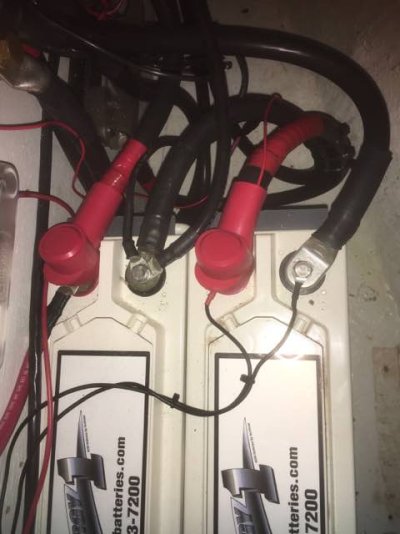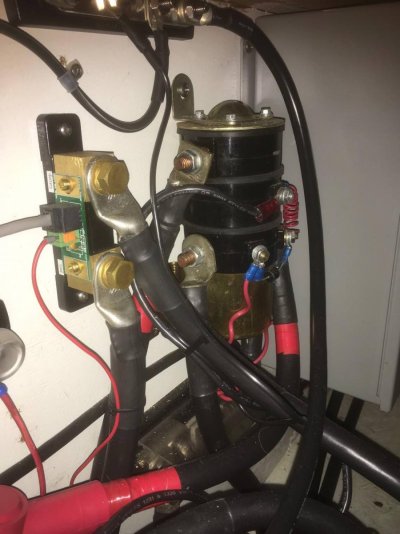JDCAVE
Guru
- Joined
- Apr 3, 2011
- Messages
- 2,902
- Location
- Canada
- Vessel Name
- Phoenix Hunter
- Vessel Make
- Kadey Krogen 42 (1985)
I'm in Klemtu with a short burst of cell service. I discovered my thruster bank was no longer being charged while under way. The equipment:
1) Wesmar 24 volt thruster.
2) 2XNorthstar Battery Company NSB M12-210, CCA 1830 amps, MCA 2350 amps. These are 12 but are connected in series with what looks to be a relay.
3) Balmar Digital Duo Charge to charge the thruster bank.
4) Victron Centaur 40 amp charger, shore power and genny.
Thruster Bank:

Relay

Charging buss bar, Digital Duo Charge is the smaller gauge wire.

So, my layman's understanding is: when the thruster is toggled at the helm, the relay trips, combines the batteries in series to 24 volts and the thruster is engaged. This is what is working now. However, I believe the draw on the Duo Charge exceeds threshold and the fuse pops. I would have thought that the Duo Charge would shut down and wait until the demand is stopped before continuing the charging procedure.
I have discovered that the inline 30 amp fuze "popped" on the house bank side of the Digital Duo charge when the thruster is engaged. Otherwise the Duo charge works. I don't have a spare 30 amp fuze right now, but the 20 amp fuses definitely "pops".
The Balmar DDC manual covered this on page 4:
"Solenoid Drive:
In applications where the Duo Charge is used to support larger capacity starting batteries (such as 4D and 8D models) or windlass and/or thruster batteries, there may be instances when the 30-amp capacity of the Duo Charge’s circuitry may not provide sufficient current to satisfy demands. When used as a stand alone charge source, the Duo Charge is designed to discontinue charging when demands exceed its capabilities. At that point, the Duo Charge will wait for a short period and query if the demand has diminished to below its 30-amp capacity. If so, the Duo Charge will continue charging. If demand continues to exceed capacity, the Duo Charge will continue to shut down, while checking periodically to see if demand has diminished.
If your application requires frequent charging levels in excess of 30 amps, it may be necessary to add a solenoid as a method to manually bypass the Duo Charge’s internal circuitry. Keep in mind, the Duo Charge will not automatically activate the solenoid if the demand exceeds its capacity. As such, it is important to monitor charging voltage closely at the battery being charged by the Duo Charge. To utilize the Duo Charge’s solenoid drive function, it will be necessary for the user to supply an appropriate-capacity solenoid and a toggle or other ON/OFF switching mechanism to control the bypass function."
So either the Duo charge has issues, the Relay is no longer functioning properly, or the Thruster is requiring more power than can be accommodated. Thoughts? Is there a more current decide than the relay that would be more appropriate in this application?
1) Wesmar 24 volt thruster.
2) 2XNorthstar Battery Company NSB M12-210, CCA 1830 amps, MCA 2350 amps. These are 12 but are connected in series with what looks to be a relay.
3) Balmar Digital Duo Charge to charge the thruster bank.
4) Victron Centaur 40 amp charger, shore power and genny.
Thruster Bank:

Relay

Charging buss bar, Digital Duo Charge is the smaller gauge wire.

So, my layman's understanding is: when the thruster is toggled at the helm, the relay trips, combines the batteries in series to 24 volts and the thruster is engaged. This is what is working now. However, I believe the draw on the Duo Charge exceeds threshold and the fuse pops. I would have thought that the Duo Charge would shut down and wait until the demand is stopped before continuing the charging procedure.
I have discovered that the inline 30 amp fuze "popped" on the house bank side of the Digital Duo charge when the thruster is engaged. Otherwise the Duo charge works. I don't have a spare 30 amp fuze right now, but the 20 amp fuses definitely "pops".
The Balmar DDC manual covered this on page 4:
"Solenoid Drive:
In applications where the Duo Charge is used to support larger capacity starting batteries (such as 4D and 8D models) or windlass and/or thruster batteries, there may be instances when the 30-amp capacity of the Duo Charge’s circuitry may not provide sufficient current to satisfy demands. When used as a stand alone charge source, the Duo Charge is designed to discontinue charging when demands exceed its capabilities. At that point, the Duo Charge will wait for a short period and query if the demand has diminished to below its 30-amp capacity. If so, the Duo Charge will continue charging. If demand continues to exceed capacity, the Duo Charge will continue to shut down, while checking periodically to see if demand has diminished.
If your application requires frequent charging levels in excess of 30 amps, it may be necessary to add a solenoid as a method to manually bypass the Duo Charge’s internal circuitry. Keep in mind, the Duo Charge will not automatically activate the solenoid if the demand exceeds its capacity. As such, it is important to monitor charging voltage closely at the battery being charged by the Duo Charge. To utilize the Duo Charge’s solenoid drive function, it will be necessary for the user to supply an appropriate-capacity solenoid and a toggle or other ON/OFF switching mechanism to control the bypass function."
So either the Duo charge has issues, the Relay is no longer functioning properly, or the Thruster is requiring more power than can be accommodated. Thoughts? Is there a more current decide than the relay that would be more appropriate in this application?
